A Year After the Quake, Nepal Is Still a Mess
Help came right away. And then it stopped. Patrick Symmes reports on the business-as-usual corruption that brought a mountain kingdom to the ground.
New perk: Easily find new routes and hidden gems, upcoming running events, and more near you. Your weekly Local Running Newsletter has everything you need to lace up! .
To reach Gati, a speck of life in the steep highlands of Nepal, you have to follow a long, circuitous path. We started at dawn with a three-mile hoof up the valley on a real road, then cut back up a rough, stone-paved jeep track for a mile to where the trail began. Then we switchbacked uphill for two hours on long paths, the kind worn smooth by villagers traveling on foot their whole lives.
At the top was Gati. Or used to be. Out of 155 houses in the hamlet, 152 were destroyed in the earthquake.
There are a lot of earthquakes up here, 60 miles west of Mount Everest. The tectonic smashing of India into Asia creates geologic upthrust, spectacular views, and scads of soft metamorphic rock that crumbles under pressure. , it shattered. Gati disappeared at 11:56 A.M., during a 7.8-magnitude temblor that lasted three minutes. If you include the fatalities from a massive 7.3 aftershock two weeks later, on May 12, almost 9,000 people died in Nepal. More than 740,000 houses were damaged or destroyed, along with several of the sites. An avalanche swept through Everest Base Camp, killing 22 people. In Kathmandu itself, cheap apartment buildings pancaked, and the historic Dharahara Tower collapsed while it was full of photo-snapping backpackers and Nepalis, killing more than 180. But perhaps no place was hit worse than the steep, crowded, and poor Sindhupalchok District, which contains Gati.
I’d almost made it to the village when I heard a chipping sound from around a bend. Someone was hitting stone with a hammer. I rounded the corner and saw four Nepalis working on a house. Two were hauling rocks to make a wall; easy enough, since they were recycling stones from a collapsed building just steps away. Another dug a shallow trench with a pickax. The oldest man—dressed entirely in gray, from his traditional suruwal trousers to the cloth topi on his head—slipped each rough, broken block into the new foundation wall. Then, working almost as fast as the rocks were brought to him, he shaped them, tap tap, squared the edges, tap tap, and knocked the stones tightly into place.
The land here, up against the Tibetan border, is inherently unstable, its verticality a draw for climbers and a curse to residents. The wall building was fast for the same reason that the quakes were devastating: Nepal is made largely of schist and sandstone and other rock that is essentially compressed mud from ancient ocean floors. The old mason had only to thump the stones’ edges to chip them. This team of four was laying a foundation faster than American contractors could have poured cement.
Gati now consisted of tarps and tents. Only three houses—the three made of wood—had survived. Everything else, constructed of those loose, unmortared stones, came down. The mountain itself had shaken free, releasing a house-size boulder that rolled through the village, its path of destruction still visible amid the shattered foundations and sun-faded tents handed out by Chinese relief workers almost six months ago. Thirteen people had died here, one of them crushed when his house was buried. You could see his tiny living room, filled almost to the ceiling by a tsunami of rock.
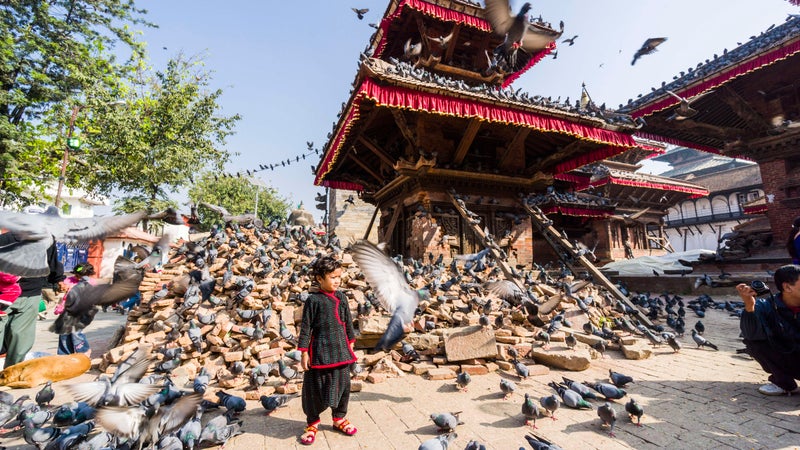
The Nepalese government has done virtually nothing for Gati. Everyone in the country who lost a house received a one-time payment of about $150, which isn’t enough to feed a family through winter, let alone rebuild. On paper there was lots of help. I saw UN organizational charts showing that Sindhupalchok alone had been helped by 21 different organizations, including the United Nations Development Programme, the Red Cross, Oxfam, ACTED, CARE, HELP, Medair, ActionAid, HelpAge, Plan, and groups known to chart makers as SCI, WVI, MC, TLMN, ILO, BF, IOM, and “Govt”—the last presumably meaning Nepal itself. But there was no Govt in Gati. The school principal, a short, broad-shouldered 32-year-old named Roshan Raj Shrestha, told me he’d seen no evidence of government response. “Some money comes from Germans,” he said, referring to a charity that had been working in the village for 11 years. “But the rest we manage ourselves.” Shrestha walked me through the ruins of the Shree Kalidevi Secondary School. The second floor had collapsed, but the quake happened on a Saturday, so no students were hurt. The first-floor walls were still standing, jagged and cracked like old teeth, bearing murals of human anatomy and charts of English verbs and prepositions.
Up the hill was the school’s replacement, an official Temporary Learning Center. This consisted of three rooms, with tin sheeting donated by the Kathmandu-based group Namaste Nepal. The walls were more tin, or chain-link fencing, or sometimes nothing at all. Wind and rain came right in; the tin roofing blew off in storms. The students had built it themselves, Shrestha explained with a mixture of pain and pride.
It was recess. In a small clearing, girls in gray uniform skirts played tag while boys in blue trousers chased a soccer ball that could fall 4,000 feet if they kicked it too hard.
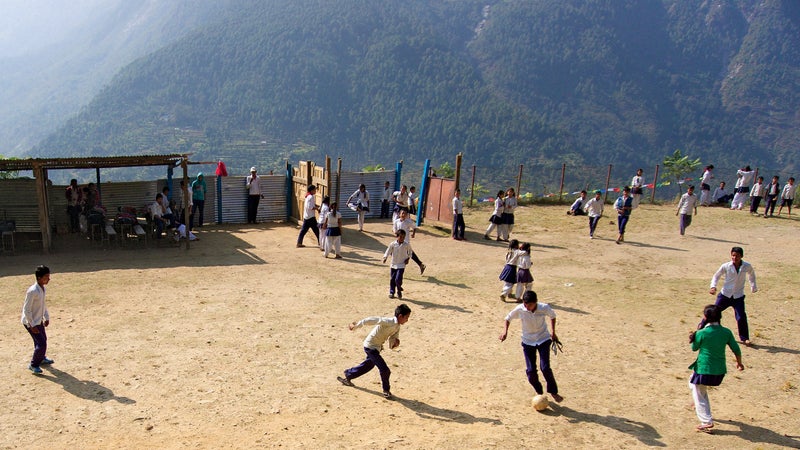
One month after the quake, global donors met in Kathmandu. Rapid surveys outlined an enormous challenge. The country had suffered $6.6 billion in damage. It would need at least $3.5 billion to reconstruct lost housing and infrastructure. The plan was to “build back better,” and there was much talk of swift action, transparency, and effectiveness. Led by Europe, the U.S., India, and China, donor nations committed $4.4 billion to the restoration.
Guess how that worked out.
After the initial days of heroic helicopter rescues and hand-digging through collapsed buildings, the first priority had been sheltering hundreds of thousands of homeless people. Summer, the rainy season in Nepal, was approaching fast. The government pledged to send tin roofing to the most remote villages—and then failed to deliver, with the money and supplies disappearing, or tin of the wrong size being sent, so that it cut the ankles of porters hauling it uphill. USAID distributed 6,200 rolls of plastic sheeting—enough to shelter 310,000 people—and much of it was still in use last October. Poor communities like Gati were last on the list to get help. The government prioritized its aid efforts according to a “scale of severity,” a map that ranked communities by how badly they were hit. But the scale was weighted toward large population centers, for efficiency in distribution, and tall buildings, because of the threat of collapse. On a 10-point scale, Kathmandu was rated 10, Gati 1.08. Those who had the least got the least.
The plan was to “build back better.” Guess how that worked out.
When the rains stopped, in September, the government pledged to provide relief before winter arrived. But by the time I left Nepal, in November, almost nothing was being distributed. Blankets and medical equipment were scarce. According to the Nepali Times, much food aid was never handed out. Ten thousand tons of Chinese rice sat rotting in Kathmandu, nine months after delivery; it was finally sold on the open market by Nepali officials. India donated huge amounts of food and cooking oil, which were eventually sold, too. Officials blamed complicated transport regulations; this excuse turned true when the country was shut down by a fuel shortage last fall. Nepal had become locked in a political dispute with India, which supplies 100 percent of its fossil fuels, from gasoline to diesel to cooking gas. When India cut off deliveries in late September, earthquake relief all but ceased.
Nepalese politics is based on patronage systems, ethnic networks, and plain old corruption. For the major parties, that $4.4 billion in pledges was a pot of gold. To prevent it from being stolen or squandered, donors had insisted on a new agency in Kathmandu to handle the money, but it took until December for Parliament to finally pass a bill creating the Earthquake Reconstruction Authority. By then winter had already shut down most rebuilding efforts.
Smaller groups did what they could. The improvised Yellow House collective in Kathmandu, named for the hostel where it met, organized rescue missions by text message; it became the fourth-largest distributor of aid in the month after the quake. Korean church groups started feeding the hungry. Jennifer Lowe Anker, the mountaineer and wife of Conrad Anker, raised $100,000, some of which a student from Montana State carried, in cash, into the Khumbu Valley in a backpack to deliver to the village elders of Phortse. Nepalis, especially the small cadre of middle-class, tech-savvy young people, organized much of the initial response. But these were stopgaps and workarounds, heroic precisely because they weren’t supposed to happen. You can’t let an entire nation be dug out by kids with cell phones.
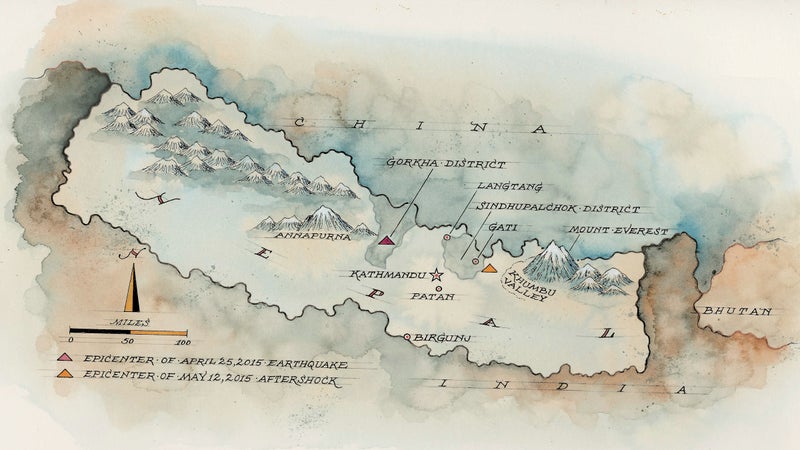
In the immediate aftermath, the UN, the Red Cross, and Doctors Without Borders responded, often quickly and well. But international relief can create a second disaster of its own. In the years since the 2010 Haiti earthquake, for example, massive amounts of international aid flowed in but accomplished little. (The Red Cross received half a billion dollars and did some good work, but its ambitious plan to rehouse Haitians, the journalism nonprofit ProPublica found, produced only six new homes.) In Nepal, big groups like Save the Children and CARE were able to continue delivering relief through long-standing programs. But with no effective partner, many other NGOs found their hands tied.
One day in Kathmandu, I spoke with a World Bank relief expert, a young Asian who asked that I not use his name. He assured me that, over the course of five years, 740,000 homes would be rebuilt. Each homeowner would receive a little money for building a foundation, a little more for putting up walls, and then more for raising a roof, with inspections at each step for each house to ensure quality and prevent corruption. I did the math: three inspections for each house came to 2.2 million site visits, minimum, in a nation whose terrain makes grown mountaineers cry. There would have to be inspectors hired and trained for thousands of affected villages—a whirlwind of paperwork and opportunities for bribery.
“Yes, it needs a lot of people,” the World Bank official conceded. “Next year, Nepal needs to train 50,000 masons. It’s a massive undertaking.” He could hear my skepticism but insisted the model was “piloted and tested.” The lights went out in the middle of our meeting, but even that didn’t phase him—he kept talking in total darkness.
From the Myanmar cyclone to the Indonesian tsunami, we’ve seen equally ineffective responses to national disasters, the unhappy marriage of a weak or corrupt state to a brief, social-media-driven spasm of foreign attention. The model was already broken when we choppered it into this impoverished old car-pet kingdom, delivering a package predestined to fail.
If the earthquake was Nepal’s only problem, then people would be fine, in the way of being fine when you lift stones all day to rebuild your house and watch your children die of disease.
“I was just having my first spoonful of dal bhat,” Megh Ale said, describing the moment when the aftershock hit last May. The lentil stew never made it to his lips. “It started and we ran outside,” he said. “You could see the wave moving through the beach and the clouds of dust from collapsing houses. Everything was shaking.”
We’d driven up into the mountains of Sindhupalchok, stopping for lunch at the same riverside place he’d been when the quake hit. I thought he meant he saw a wave of water. He shook his head. No, the shock waves had been moving through the stones on the beach, millions of pounds of rock shivering on the skin of the earth. He’d heard a weird rustling sound, too, from tens of thousands of trees slapping against each other, and then the deafening noise of landslides. We’d already seen where, in 2014, one slide, half a mile long, had buried 80 people and filled the riverbed, creating a dam of silt that stayed in place for 13 hours. When the water flowed out, houses emerged, half-buried in gray mud.
Ale, 55, the Nepali owner of a rafting company called Ultimate Descents Nepal, needed to check on the , his camp alongside the raging Bhotekosi River, which offers some of the steepest whitewater in Nepal. He had agreed to accompany me up from Kathmandu in a hired Land Cruiser if I paid the driver and sprang for the tank of black-market gasoline. Two months into the fuel crisis, smuggled gas and diesel were selling for ten and twenty times the normal price.
That afternoon, Ale had dropped me at the camp, a collection of comfortable thatch-roofed cabins, and the next morning I began my roundabout walk up to Gati. (It was his group, Namaste Nepal, that helped build the temporary school.) I was there just a few hours. Somehow, the walk down from the village felt harder—a direct drop on precipitous stairways and muddy paths into the Bhotekosi valley, slipping and sliding on eroded bluffs that overlook thousand-foot plunges. I lost altitude so fast my ears popped, as did my knees. Twice we encountered teams of villagers working to repair stone stairways. A Norwegian NGO was paying them with food: a month of part-time labor earned 130 pounds of lentils and 90 pounds of rice, enough to keep a family alive for the coming winter.
It was sunset when I limped back to Borderlands. Like most of the country, it had been empty of foreign tourists when I arrived. But now I saw that the camp’s tiny meadow was covered in orange tents. The camp manager, a wiry Nepali named Jit Tamang, told me that a relief mission had arrived, a group of foreign medical experts. I thought he said something about Doctors Without Borders. Finally, someone was here to help.
I rushed down to the dining area and found . The New Mexico–based group had brought a dozen practitioners from the U.S., Belgium, Ireland, and China to treat earthquake victims. Acupuncture is a credible treatment, traditional in Asia for everything from chronic pain to indigestion, but I couldn’t help but look around for a team of engineers carrying rebar and foundation ties. This was it?
Diana Fried, the executive director of AWB, offered to prick me. I shook her off. “I’m fine,” I told her.
“It’s free,” she said.
After watching poor women lift rocks all day, I was reluctant to whimper about my knees. I told Fried I was fine, absolutely fine. Sometimes it’s OK to lie.
Slowly, rural women began to trickle in to the resort, wearing filthy red homespun dresses and busted sandals. One by one, the acupuncturists stuck their ears with small needles—a protocol believed to restore even the most traumatized nervous system to a state of calm—and then laid them out on soft blankets. The Nepali women rested there, eyes closed, blissful. A self-professed energy worker in yoga pants waved her hands over their chests, claiming to draw out toxins.
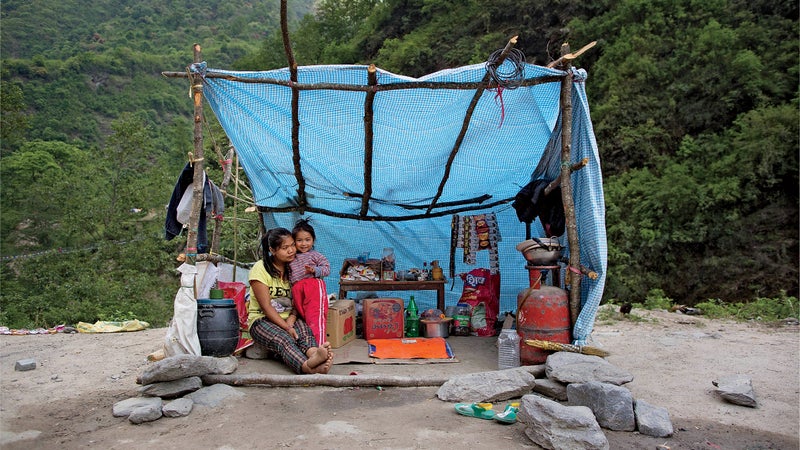
If the earthquake was Nepal’s only problem, then people would be fine, in the way of being fine when you lift stones all day to rebuild your house, watch your children die of communicable diseases, and see your local schoolhouse sit destroyed and empty for six months because the patrician class in Kathmandu can’t get organized to receive and spend $4.4 billion. They’d be fine in the tough way of Asian peasantry, their mute suffering ignored in the capital and labeled cultural resilience by foreigners.
But Nepal’s problems run deeper than any earthquake or fuel crisis. “What you are seeing in Nepal,” said Ben Ayers, country director of the Colorado- and Kathmandu-based , “is the government doesn’t give a shit about the people.”
Ayers, a 39-year-old American climber, has lived and worked in Nepal for 18 years—first with , a nonprofit he founded to help the trekking laborers who help carry Nepal’s tourism industry on their backs, and then, since 2007, as director of dZi, which aims to improve quality of life throughout remote Nepal. We drank black tea in his office in a two-story house in Patan—once an ancient rival to Kathmandu, now a suburb with the space and charm of an older Nepal where a lot of aid groups and charities have set up shop. Ayers was part of that fast-and-light wave of quake response by young Nepalis.
Foreigners had taken part, too. A Canadian climber named Heather Geluk recalled volunteers getting pinged each morning about where to meet a truck: the details would be worked out on the fly. But key to that quick response, Ayers said, was its reliance on Nepalis themselves.
“They didn’t have to ask directions,” he said. “They didn’t need a translator or maps. They didn’t wear funny hard hats and safety vests like many foreign aid groups require. They didn’t need to negotiate any of the traps that relief agencies do. They just went out and delivered aid.”
That might have been effective if the April 25 earthquake had been the end of the destruction. Two and a half weeks later, on May 12, a powerful aftershock hit—a 7.3 that lasted several minutes. Geluk was in both quakes, and she said the second was worse. During the first, she was on Shishapangma, just over the border in Tibet. After a few terrifying minutes, everything went back to normal, birds flitting overhead. But the aftershock hit a country already weakened and afraid. Caught on the third floor of a Kathmandu building, she saw terrified people fighting to get down the stairwell. Many structures left standing in the first shake fell down during the second.
“This is going to sound weird,” Ayers said, “but the earthquake just made Nepal more Nepal.” All the things foreigners love best about the country emerged during the quakes. People of all backgrounds came together. They showed “resilience and the ability to pick themselves up by the bootstraps,” he said. “On the other side, all the things that have made Nepal poor in the first place—the terrible governance, the resource issues, the geopolitics—the earthquake just amplified everything.”
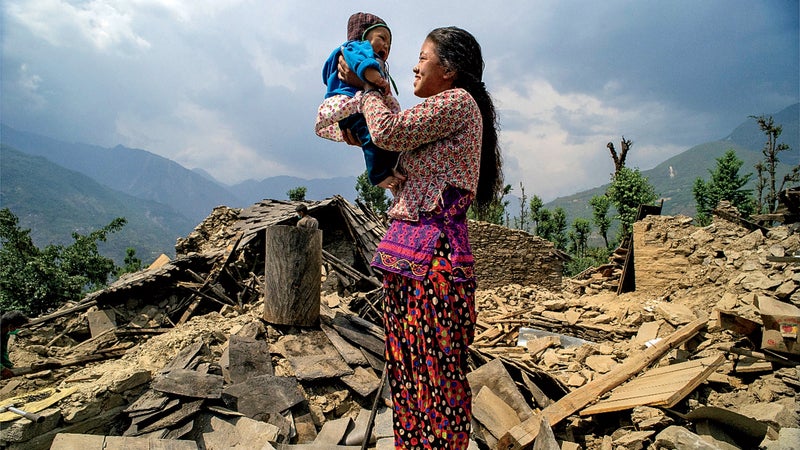
Like Nepalis, I walked or hitchhiked everywhere. I walked far outside the storied and sensual old Kathmandu of cobbled lanes, carved wood, and birdlike pagodas, into the prosaic, somewhat ratty new city, built up since the 1970s by rural immigrants and now stuffed with people forced out of their mountain homes. I walked along the Bagmati River, once a sacred spring and now a brown sewer known to English speakers as the Bagmuddy, and joined a group of volunteers who’d met for 130 Saturdays in a row clearing out baskets of plastic scraps and unidentifiable organic waste, exposing green grass to the weak sun. Some things were still possible here.
On a cool Saturday morning, I stuck my thumb out and a young, formally dressed Nepali in a Volkswagen picked me up. He was a radiologist at a local hospital. “I get a special allowance of gasoline,” he explained, so he felt obliged to give someone a ride. As bicyclists and pedestrians coursed around us, he paused to call up Judas Priest on his iPhone, and we headbanged our way down empty avenues. “All the politicians are getting rich on the fuel blockade,” he told me. He laughed with a cynic’s pleasure as he described how leaders spouted nonsense about building giant wind farms to solve the energy crisis; meanwhile, they didn’t bother to arrange for the import of vital medicines by air, and he knew of two patients who’d been sent home to die for lack of essential drugs. “Good luck,” he said as he dropped me off.
I was walking in Patan when I came across a line of white Mahindra pickup trucks, hundreds of them. A few fuel trucks were sneaking across the border every day, and the arrival of three from China was front-page news. The drivers at the head of the queue told me they had been waiting two days for diesel, those at the back just eight hours. Another line snaked out from a station a few miles away, thousands of motorcyclists waiting for gas with the calm patience that is Nepal’s blessing and curse.
The gas shortage was a new and cruel twist on the country’s suffering. It had begun when bitter rivals in Parliament all united to ram through a new constitution, one that gerrymandered the traditional hill tribes and high-caste politicians into power while diminishing the roles of women, promoting Hinduism over other religions, and excluding millions of Nepali-born people from full citizenship.
The excluded people, the Madhesis, lived in the lowland region that borders India. They make up perhaps half of Nepal’s population, and when their protests over the new constitution were met with tear gas, they occupied and eventually shut down main border crossings to India in the city of Birgunj. When Nepali police fired rubber bullets, the protestors burned several gasoline trucks from India, which in turn banned all further fuel deliveries.
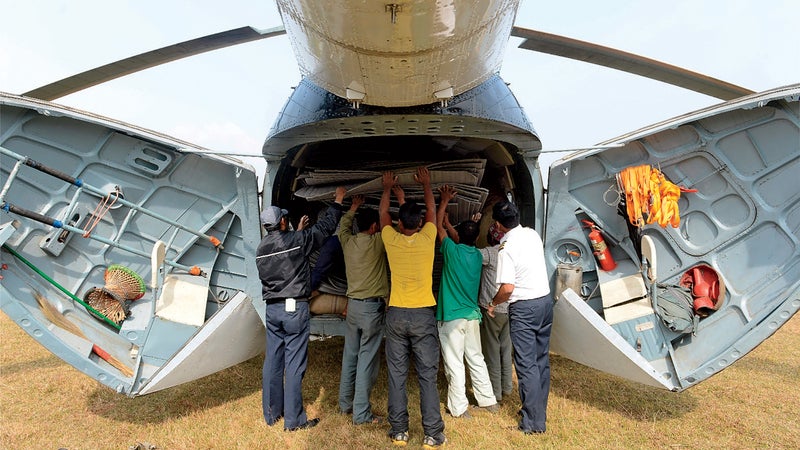
Now there was no way to truck roofing tin, bricks, cement, rebar, wood, medicine, and schoolbooks toward the mountains. “The fuel blockade was worse than the earthquake,” Megh Ale had insisted. Taxis stopped running; for once the bicycle rickshaw drivers were kings. In Kathmandu, a man wobbling by on a mountain bike shouted at me, “Please, sir, India has done this! India is nonfriendly country to Nepal! Please we ask you to internationalize this problem!”
Tourism, only 9 percent of the economy, is nonetheless a crucial source of cash. During late 2015, the country felt ruinous, with both fuel and foreigners—the climbers, the hikers, the seekers, and the helpers—in short supply. Only 15 percent of trekking routes had been damaged, but according to the Kathmandu Post, the number of foreigners hiking in the Khumbu was down by half from the year before. By spring, the news was better. “Reconstruction is happening,” said Mingma Dorji Sherpa, of Last Frontiers Trekking, which runs REI’s adventures in the country. He talked about rebuilt stupas and historic sites in Kathmandu and more aid reaching the backcountry. “Life is back and we’re in business,” he said.
Still, 2015 was a gut punch. Even six months after the quake, I found the normally chaotic lanes of Kathmandu’s Thamel tourist quarter eerily quiet. One of the only groups of travelers I met was a bunch of Australian motorcyclists, a dozen tatted bad boys getting around on old Enfield Bullets fueled by filthy black-market petrol.
Two months into the blockade, violent protests were a daily event. Nineteen people had already died at the border. Around the time I finished drinking tea with Ayers, he looked at his phone and sighed. “One dead in Birgunj. About three hours ago.” A 19-year-old protester battling Nepali police had been shot; awkwardly, he turned out to be an Indian citizen.
Much food aid was never handed out. In the worst example, 10,000 tons of Chinese rice sat rotting in Kathmandu, nine months after delivery. It was finally sold on the open market.
It's only 54 miles from Kathmandu to the border city of Birgunj, but in a country with no gasoline it was easier to fly. (The national airliners refilled in India daily, often leaving luggage behind to carry more fuel.) The 15-minute hop to Simara Airport was the shortest flight of my life. But no one had enough gasoline to run a motorcycle the final 15 miles to the border, and I had to spend the night. Finally, late the next morning, I rode on the back of a Honda motorbike through cool green fields and past burned fuel tankers into Birgunj. The town was teeming with blue-clad police and a few human-rights monitors. In the no-man’s-land between border posts, the Madhesi protesters had occupied the bridge to India. It was dappled with rocks and black banners and tenting. The arrival of a foreign journalist triggered a reality-distortion field—a hundred sleepy men got up, formed into lines, began chanting slogans (“Madhesi people power!” and “We are 50 percent of the country!”), then lectured me on imperialism for a while. Soon they were preparing to march, rocks in hand, on the local police station.
I hustled over there. A noncommissioned officer in blue fatigues and flip-flops admitted it was true, they had shot an “agitator” two days before, when he attacked them
inside their police post. He was relaxed about the protest forming up on the bridge—it
happened every day at this time.
He looked at his watch and said, “Curfew starts in 12 minutes.” It was only noon. He told me to grab my driver and clear out or face a long day and night trapped in town. We rolled out of Birgunj as the riot police were hitching up their armor and loading shotguns. By nightfall I had unwound my awkward journey back to Kathmandu.
In February, fuel deliveries finally resumed, eventually, mostly, sort of. A year after the quake, a government loan program has kicked in, tourism is rebounding, and reconstruction of temples, homes, and historic sites, often privately funded, is finally progressing. “It’s not rabbit speed,” Mingma Sherpa told me. “Things are moving slowly, but at least they are happening now.”
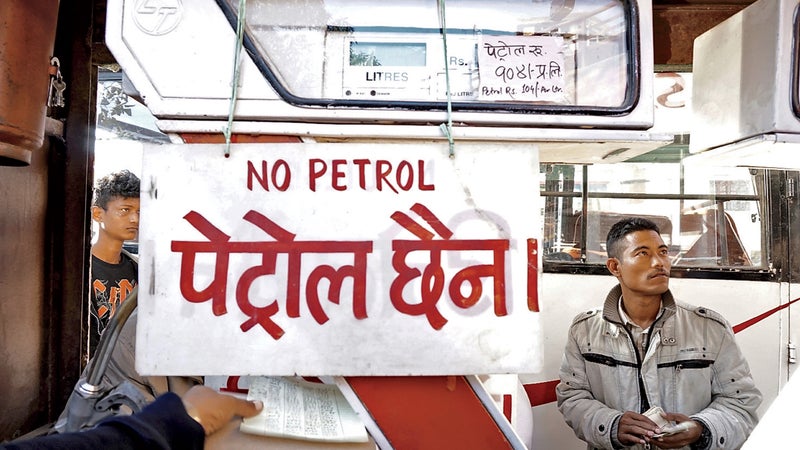
My last walk in Nepal was to Nagpuje, a village in Sindhupalchok located over a suspension bridge and up a set of steep trails, on the far side of the Bhotekosi from the villages I had seen before. After a few hours, I was dripping sweat and gasping when I topped out on the flat nose of land that stuck over the terraced rice fields below.
Tamang, the Borderlands Resort manager, walked with me at first, and we discussed a nasty business feud that had affected the valley. Borderlands had been founded by the late David Allardice, a New Zealander, who was eventually pushed out by his partner, Ale. Most tourist businesses in Nepal seemed to crash this way, foreigners starting with good intentions and ending with disputes over who was owed what. “Money make Nepali people crazy,” Tamang said.
In Nagpuje, the local English teacher, a thoughtful, thin-haired city man named Bhopal Bahadur Sunuwar, walked me through the ruins. Of 415 people in the village, seven had been killed; in the larger village district, 92 had died. “Not any houses survive,” Sunuwar said. Every family was living in a tent, under a tarp, or in a shed made by bending a single sheet of corrugated roofing into a tiny Quonset hut. Aside from a small payment of survivor benefits, “Nepali government, they have not given anything,” Sunuwar said.
The district’s 315 students were studying in the ruins of their old school, topped with new tin sheeting. Sunuwar showed me a cabinet holding the only equipment that had survived the earthquake: three microscopes and a single computer and printer. A few yards away was a large cement foundation; the iron rebar poking up from the four corners was the only evidence I saw in all of Nepal that any new construction would be built to a higher standard. It had been paid for by the US Nepal Welfare Society, a community group in Austin, Texas, one of many small nonprofits working outside the broken system in Kathmandu.
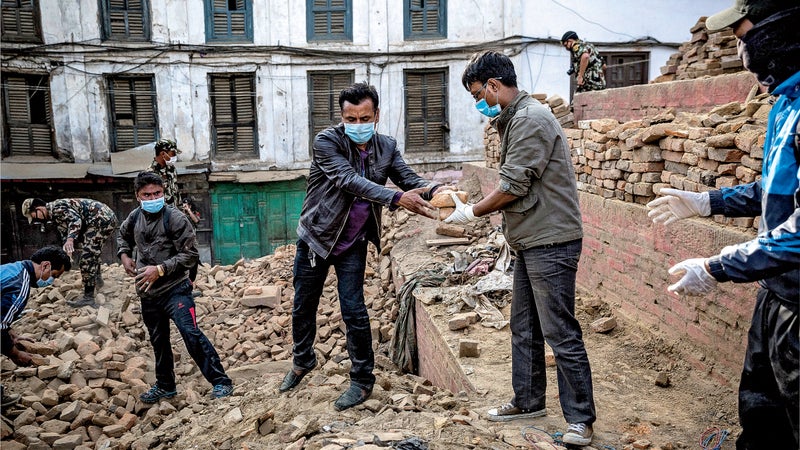
It was surreal to walk back out of the hills one last time, alone, down winding trails into the Bhotekosi valley. The hours went by in an endless, meditative slog, my boots finding their own way back to the road.
Instead of turning downhill, toward Borderlands, I headed uphill, walking another three miles to a spot high above the river. When the business dispute over Borderlands had blown up, the former owner simply started over, building a new, even nicer place called the Last Resort. Here, footsore and heartbroken, I settled in among tropical plants and Buddha statues, healing with the roar of the river as my medicine.
But there was a louder roar that night, and some combative boasting in Australian accents. I limped up to the dining area and found the motorcyclists I’d met in Kathmandu ten days before. They’d managed to shove their crappy Enfield Bullets all the way to the remote mountain kingdom of Mustang, through dust, mud, and the fuel blockade. They were sunburned, bruised, and utterly filthy, celebrating their last night on the road amid the comfy cushions of the Last Resort. We started drinking immediately. I didn’t have anything to celebrate, but I joined in the toasting, the selfies and Down Under cheer. It helped to listen to Sydney DJs and blow off steam. When did Nepal become so devastating?
I went to sleep in my safari tent that night, craving rest, but in the middle of the night I heard a desperate cry. Slowly, disbelieving, I realized it was the voice of my young son. He was pleading for me. Daddy, he was yelling. Daddy!
I gripped the bed, helpless, and dragged my brain up to consciousness only to find I was alone in a tent, a planet away from my family. My watch said it was 2:15 a.m.
At breakfast another guest—a geological surveyor from Kathmandu—smiled and asked how I had enjoyed the earthquake.
The what?
“Just an aftershock,” he said. “Four point two, maybe five.”
It had lasted ten seconds at most, he said, and the rattling of tin roofs had set some local children to screaming. People had run out of their houses in fear. He talked about the Himalayan Front fault line, upon which we were sitting, and the performance of various rocks when placed under pressure.
“What time?” I asked.
“About 2:15.”


